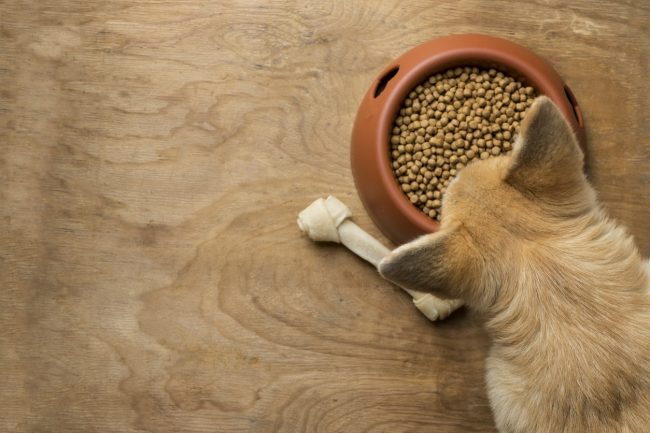You’ve cut out the gluten, started subbing spaghetti squash for regular pasta and learned you rather have more olive oil in your salad than the calories from a dinner roll. You’ve even lost a few pounds in the process, and now your family is on board. So why are you still feeding kibble to your pets?
Even some of the top brands of pet food you can get from our vet contain unknown, hard-to-pronounce ingredients. Here’s a look at the nutrition label of canned Hill’s Science Diet® Adult Chicken & Beef Entrée:
Water, Chicken, Beef, Beef By-Products, Pork Liver, Rice, Cracked Pearled Barley, Whole Grain Corn, Corn Gluten Meal, Chicken Liver Flavor, Soybean Oil, Potassium Chloride, Calcium Carbonate, Dicalcium Phosphate, Choline Chloride, Iodized Salt, vitamins (Vitamin E Supplement, Thiamine Mononitrate, Ascorbic Acid (source of Vitamin C), Niacin Supplement, Calcium Pantothenate, Vitamin B12 Supplement, Pyridoxine Hydrochloride, Biotin, Vitamin D3 Supplement, Riboflavin Supplement, Folic Acid), L-Lysine, minerals (Zinc Oxide, Ferrous Sulfate, Manganese Sulfate, Copper Sulfate, Calcium Iodate), Iron Oxide color, Beta-Carotene.
This is a popular brand of pet food, and even it isn’t the perfect picture of pet health. With pets eating such processed foods, it’s no surprise that over half of all pets in the United States are overweight.
In addition, pets are coming down with a host of illnesses and allergies that they never had before. Similar to what humans might experience when you feel ill, often, dogs and cats are given tests and various procedures before diet is even addressed. Homemade pet food may be your best option.
What are the best pet food options?
You have a choice: 1) prepare homemade pet food or 2) test out some readily available, human-grade pet food options that are becoming more popular and more accessible.
Keep in mind that meal prep for pets at home is more than just sautéing some ground beef. It’s important to factor in everything they’d be getting naturally in the wild (hint: no fortified food with additives).
Not being mindful about how you’re preparing your pet’s food can work against the best of intentions, according to Dr. Korinn Saker, a clinical nutritionist at the College of Veterinary Medicine at North Carolina State University. “If not done correctly, the consequences could be harmful,” Saker says.
How can you quickly food prep for your pet?
- Search for grass-fed meat vendors at farmer’s markets. Their costs tend to be low, and they may have hard-to-find meats your pet would love (even if you don’t).
- Cook in bulk and store extra food in the freezer. One prep batch a week is sufficient and fits into even the busiest schedules.
- Make meals for the entire family at once. Instead of just putting food on the table for all the humans in your house, cook for the cats and dogs, too.
- Shop online for readily available, grain-free pet food. Vitacost.com will help you save money and time, because it gets shipped straight to your door. If your pet likes what they taste, put their food on Set & Save for automatic delivery.
If you’re unsure of the best solution for your pet, consult with an expert. The American Holistic Veterinary Association can help point you in the direction of a professional near you – someone who is likely to be well-versed in the food component of your pet’s health.

